BRICS Summit 2025, in Brazil

Some general observations about the international situation
Chinese Foreign Minister Wang Yi noted, in late April 2025, that the world is witnessing a “fierce game between unilateral and multilateral orders” and “a struggle between hegemony and forces opposing it”. China and Russia must work together to strengthen coordination within BRICS and deepen solidarity and cooperation among developing countries, Chinese Foreign Minister Wang Yi said during a meeting with his Russian counterpart, Sergey Lavrov, in Rio de Janeiro.
“The unity and cooperation of BRICS countries are acquiring increasingly important strategic significance,” Wang Yi said. “As two of the founding members of BRICS, China and Russia must reinforce coordination and cooperation within this framework and deepen solidarity and collaboration among developing nations and emerging market economies,” he added.
Great power competition, de-dollarization, “tariff wars” and new international currency system, new world order, NATO – BRICS & SCO confrontation, Ukraine war and crisis in the Middle East (Israel – Iran conflict) are all reasons / indications that various tensions are escalating worldwide.
In addition, based on experience from recent conflicts in Ukraine, Middle East and Kashmir, five key points / features can be found in today’s warfare and military conflicts:
- effective military-industrial mobilization
- massive use of drones and UAVs
- massive use of missiles and glide bombs with GPS guidance in precision strikes, particularly hypersonic missiles
- artificial intelligence (AI) in warfare
- networks beat mixed fleets in modern air warfare
These points have significant impact on the modern warfare.
As stated many times in my articles on this website before, the humanity seems to be divided in two camps:
The Western Camp, “Axis of Empire” (the US and its allies Canada, EU and other West Europe, NATO, Australia, New Zealand, Japan, South Korea) and The Eastern Camp, “Axis of Resistance” led by China and Russia and their close allies Iran and North Korea, CIS and CSTO countries, covering majority of Asia, Africa and South America, so called “Global South”.
The eastern group consists of the majority of humanity, both in terms of countries and people. The ratio is six billion people in the east to one billion in the west. No doubt, which camp will prevail. The leadership will shift to the east and remain there well into the next century.
Expanding BRICS
Initially founded in 2009 as BRIC – by Brazil, Russia, India, and China – the organization grew in 2010 with the addition of South Africa. At the 2023 summit in Johannesburg, South Africa, BRICS expanded again, inviting six more countries: Argentina, Egypt, Ethiopia, Iran, Saudi Arabia, and the United Arab Emirates. From those countries Egypt, Ethiopia, Iran, and the UAE accepted the invitation and officially became BRICS members in January 2024. Saudi Arabia still had not made a formal decision as of the end of 2024. Argentina initially agreed to join, when it had a center-left government led by President Alberto Fernández and Vice President Cristina Fernández de Kirchner. However, far-right pro-US leader Javier Milei came to power in December 2023, and he overturned the decision, blocking Argentina from joining BRICS in January 2024.
Update January 7, 2024: Indonesia was admitted as a full member of BRICS on January 6, 2025. This was announced just two weeks after Russia had revealed that Indonesia was one of nine countries that were added as BRICS “partners”. This means that BRICS now has 10 full members, consisting of the following: Brazil, Russia, India, China, South Africa, Egypt, Ethiopia, Indonesia, Iran, United Arab Emirates
Joining the 10 BRICS members are eight partner countries that are on the path to full membership. These are: Belarus, Bolivia, Cuba, Kazakhstan, Malaysia, Nigeria, Thailand, Uganda, Uzbekistan, Vietnam
The following is an updated map showing the members and partners of BRICS, as of January 7, 2025:
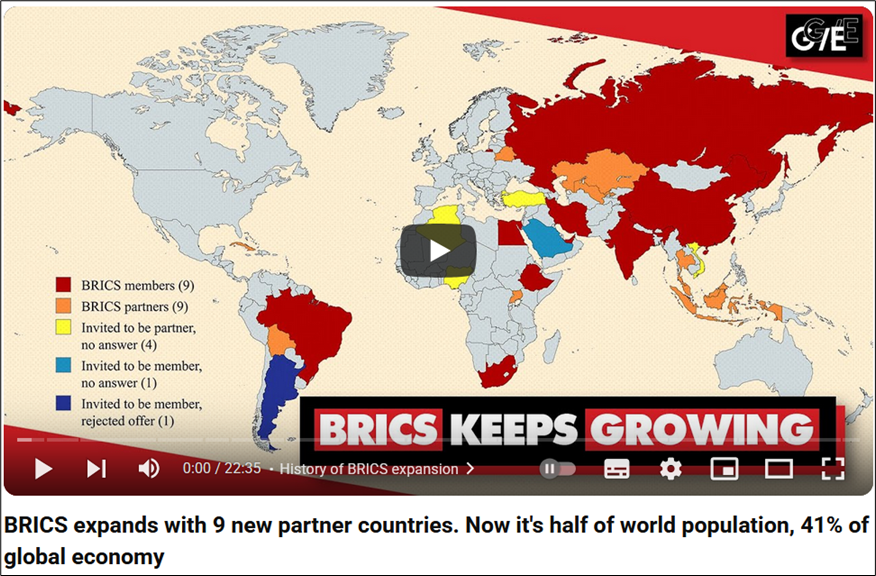
BRICS expands with 9 new partner countries. Now it’s half of world population, 41% of global economy
Geopolitical Economy Report, Ben Norton analyzes the growing influence of BRICS+. December 24, 2024
The Brazilian government announces, June 14, that Vietnam’s official accession as a partner country. Thus, Vietnam has become the BRICS 10th partner country.
At the BRICS summit in Kazan, Russia in October 2024, 13 countries were invited to become BRICS partners, meaning they are on the path to full membership in the near future. Nine of these 13 nations accepted the invitation. The remaining four did not give a formal response as of the end of 2024. These were Algeria, Nigeria, Turkey/Türkiye, Vietnam. The Russian government, which in December announced the admission of the nine new partners, emphasized that “we expect that in the near future responses will come from” the other four.
BRICS keeps expanding, adding partner countries in January 2025, after admitting new members in 2024. It now makes up roughly half of the global population and more than 40% of world GDP (PPP). It’s an economic powerhouse, with top producers of key commodities like oil, gas, grains, meat, and minerals.
The BRICS Foreign Ministers’ Meeting took place on April 28-29 in Rio de Janeiro. Preparations for the April 30 meeting in Brasilia of high-level representatives in charge of security issues are also in our focus. At the same time, meetings on environmental protection and artificial intelligence are being held at the working level in the Brazilian capital. Since Indonesia was admitted as a full member of BRICS in January, several important events have taken place.
At the BRICS Foreign Ministers’ Meeting held in Rio de Janeiro on April 28, 2025, Russian Foreign Minister Sergey Lavrov emphasized several key themes reflecting Russia’s strategic priorities within the bloc:
Advocacy for a Multipolar World Order
Lavrov portrayed BRICS as a platform promoting a multipolar global system, challenging Western dominance. He criticized the United States for employing trade as a tool of coercion and for attempting to impede the emergence of new power centers.
De-dollarization and Financial Sovereignty
Highlighting the shift away from the US dollar, Lavrov noted that approximately 65% of Russia’s trade with BRICS countries is now conducted in national currencies. He mentioned ongoing efforts to develop alternative payment systems and platforms to reduce reliance on Western-controlled financial mechanisms like SWIFT.
Expansion of BRICS Membership
Lavrov discussed the bloc’s openness to expanding its membership, referencing the creation of a “partner country” category to include emerging economies aligned with BRICS values. He emphasized that this move is not about isolation but about building inclusive partnerships.
Economic Cooperation and Development Initiatives
He announced plans for establishing a BRICS Development Bank aimed at financing infrastructure and sustainable development projects within member countries. Lavrov also stressed the importance of embracing digital technologies to enhance trade, services, and innovation across the bloc.
Reform of Global Institutions
Lavrov reiterated the need to reform international institutions like the United Nations and the International Monetary Fund to better reflect the current geopolitical landscape and address the needs of developing nations. He argued that such reforms are essential for creating a more just and equitable world order.
Overall, Lavrov’s remarks at the BRICS meeting underscored Russia’s commitment to fostering a multipolar world, enhancing financial independence from Western systems, and promoting inclusive economic development through strengthened cooperation among BRICS nations.
On February 25-26, the first meeting of the sherpas and sous-sherpas of the organization was held in Brasilia. Then, already in March, productive consultations were held involving the heads of foreign policy planning departments of the BRICS Foreign Ministries. In late March, traditional consultations of BRICS deputy foreign ministers on the Middle East and North Africa were held. The Brazilian side has actively taken up the work of the BRICS presidency.
BRICS Summit 2025, July 6-7, in Rio, Brazil
The BRICS Summit was held in Rio de Janeiro on July 6 and 7. Besides the group’s members and partner states, other countries participated, including Mexico, Turkey, Uruguay and Chile. The main topics of discussion were healthcare, trade, investment, finance, climate change, artificial intelligence management, and strengthening peace and security.
On July 6 and 7, Rio de Janeiro hosted the 17th BRICS Summit. Russian President Vladimir Putin took part in the upcoming BRICS Summit via video link. Russian Foreign Minister Sergey Lavrov will lead the Russian delegation at the event from July 6-7. On the sidelines of the summit, Lavrov is scheduled to participate in multilateral meetings, where the heads of delegations will talk about BRICS work in three main areas: politics and security; economy and finance; and cultural and humanitarian issues. The minister will also hold a series of bilateral meetings.
The Russian president thanked his Brazilian counterpart, Lula da Silva, and the Brazilian BRICS presidency in promoting the strategic partnership within the association. Putin’s address at the BRICS summit in Rio de Janeiro has dominated Brazil’s major newspapers. In his speech, the Russian president stated that BRICS significantly surpasses the G7 in economic terms, while liberal globalization has exhausted itself. Putin emphasized that the bloc continues to expand and enjoys broad support among nations of the Global South and East.
Strengthening a multilateral world order is one of the major challenges for the BRICS group, Sergey Lavrov said. In order to make consensus-based decisions, it is crucial to seamlessly integrate new members and partner states. Now, the challenge for BRICS is to make sure that new members and partner states join the group in a smooth manner and become part of its activities. In economic terms, reducing reliance on the US dollar is essential for BRICS nations. This is a cornerstone of economic policy because whoever has the money, runs the economy. American prosperity is believed to be largely based on the fact that other countries have to purchase dollars to use them for payments.
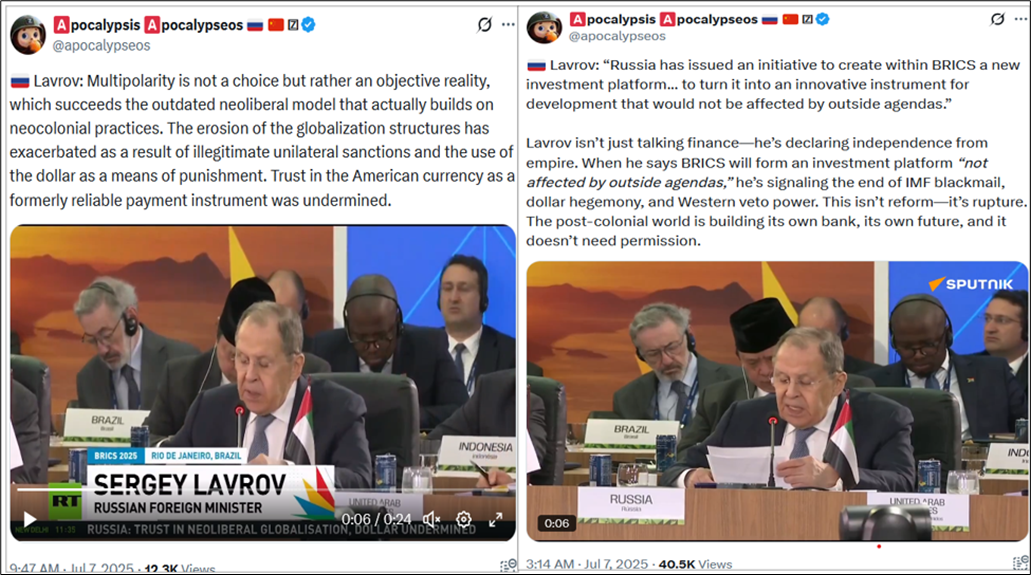
Chinese President Xi Jinping will not attend the BRICS summit in Rio de Janeiro. Beijing informed the Brazilian government that the Chinese delegation to the summit will be led by Prime Minister Li Qiang. The Chinese president will not show up because he has already met with Brazilian President Luiz Inacio Lula da Silva twice in less than a year: first at the G20 summit in Brazil last November and then during a conference called China-Community of Latin American and Caribbean States that took place in Beijing in May.
China is aligning its foreign policy with the agenda of the BRICS group.
For China, BRICS is becoming increasingly relevant. China has always paid attention to BRICS, was one of the founders of this platform, but always treated it as secondary, because for a long time the main thing for China was its own Belt and Road initiative, direct bilateral ties, and one-on-one interaction. In this sense, multilateral platforms like BRICS served more as a supplementary tool than a mainstay. Now it is becoming clear that even such seemingly grandiose projects as the Belt and Road initiative cannot be promoted alone, and China is moving to other positions.
BRICS offers a platform where China can play an influential role and have its voice heard and the country is now actively talking about the need to restructure global governance, and the positions of China and Russia on how the world should be governed are aligned. The UN needs to be reinvigorated. It is necessary not to break off ties with the WTO, for example, but on the contrary to cooperate with the WTO. It is necessary to introduce the new BRICS development bank as a major player. China is really in favor of multipolarity, for it this is simply a key issue, and here the Russian and Chinese positions coincide.
Tariffs and sanctions are also an area of concern for China. It is China that strongly condemns this situation, when US President Donald Trump promises to impose 10% duties on the countries that cooperate with BRICS. In fact, these are almost all Asian countries, because every single country is a Chinese partner, and China feels that the blow is aimed not even at BRICS, but against it personally.
China has always advocated that all conflicts be resolved peacefully and through negotiations, but now the country is also emphasizing its willingness to act as a carrier for resolving these conflicts.
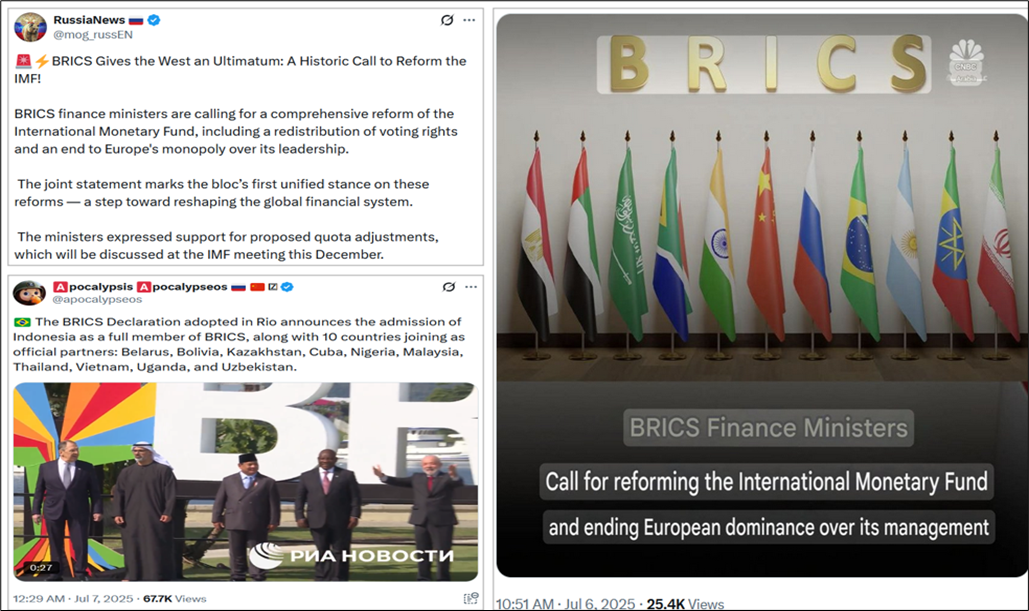
BRICS Summit, joint declaration seal group’s commitment to multilateralism
The growing BRICS group gathered in Rio de Janeiro, Brazil for the 17th BRICS Summit on Sunday, and signed a joint declaration encompassing 126 commitments covering global governance, finance, health, artificial intelligence, climate change, and other strategic areas. The document sealed the group’s commitment to strengthening multilateralism, defending international law, and striving for a more equitable global order.
Addressing the plenary session themed “Peace and Security and Reform of Global Governance” at the summit, Chinese Premier Li Qiang said that BRICS countries should strive to become the vanguard in advancing the reform of global governance, calling on the bloc to safeguard world peace and tranquility, and promote the peaceful settlement of disputes. The expanded BRICS mechanism, with its vast economic scale, large populations, and significant contributions to the global economy, are gaining influence on the global stage.
As the leading force of the Global South, BRICS countries should uphold independence and self-reliance, demonstrate a sense of responsibility, and play a greater role in building consensus and synergies, Li said. Noting that China will establish a China-BRICS research center on new quality productive forces this year, Li also announced a scholarship established for BRICS countries to facilitate talent cultivation in sectors including industry and telecommunication.
The summary of the key results from the BRICS Summit 2025 in Rio de Janeiro:
- Expansion and Membership
• The BRICS group reaffirmed its commitment to expansion, welcoming new members and discussing further enlargement.
• There was consensus on deepening cooperation with recently admitted countries and evaluating applications from additional interested nations. - Economic Cooperation
• BRICS leaders agreed to strengthen trade and investment ties among member states, with a focus on reducing reliance on the US dollar in cross-border transactions.
• The summit advanced discussions on creating a common payment system and expanding the use of local currencies for trade within the bloc. - Development Initiatives
• The New Development Bank (NDB) announced new funding for infrastructure and green-energy projects across member countries.
• Special emphasis was placed on supporting sustainable development and climate resilience in the Global South. - Geopolitical Stance
• The BRICS nations issued a joint statement calling for a multipolar world order, emphasizing respect for international law and the sovereignty of nations.
• The group expressed concern over ongoing global conflicts and called for peaceful resolutions through dialogue. - Technology and Innovation
• The summit launched new initiatives for cooperation in digital infrastructure, artificial intelligence, and cybersecurity.
• Plans were made to establish a BRICS technology forum to share expertise and foster innovation. - Global Governance Reform
• BRICS leaders reiterated calls for reform of major international institutions, including the United Nations Security Council and the International Monetary Fund, to better reflect the interests of emerging economies.
BRICS voiced serious concerns about the rise of unilateral tariff and non-tariff measures which distort trade and are inconsistent with WTO rules. Brazilian President Lula da Silva criticized NATO’s decision to hike military spending by 5 percent of GDP annually by 2035.
The 17th BRICS Summit was held under complex circumstances, particularly with intensified US pressure on the mechanism. Despite this, the summit was successfully convened and achieved pragmatic outcomes, playing a pivotal role in shaping BRICS’ future development.
This summit adopted a more simplified, efficient, and practical approach, focusing on six priority areas, including climate change, AI governance, and global public health governance, to deliver tangible results, Xu said, adding that the summit reaffirmed the BRICS spirit, principles, and objectives, solidifying the foundation for future cooperation and ensuring cohesion in a larger framework. The summit maintained a low-key and moderate stance on sensitive issues, emphasizing BRICS as a development-focused platform rather than a confrontational bloc targeting any third party.
Resisting pressure from outside
In a Truth Social post on July 6, US President Donald Trump threatened to impose an additional 10 percent tariff on “any country aligning themselves with the Anti-American policies of BRICS” with “no exceptions,” though it was not immediately clear which policies Trump was referring to. Trump has previously threatened to impose 100 percent tariffs against the bloc if they take any moves to undermine the dollar.
Responding to the latest threat, Chinese Foreign Ministry spokesperson Mao Ning said at Monday’s press briefing that BRICS is an important platform for cooperation among emerging markets and developing countries. It advocates openness, inclusiveness and win-win cooperation. It is not a bloc for confrontation. Nor does it target any country. “On the US tariff hikes, China has made its position clear more than once. Trade war and tariff war have no winners, and protectionism leads nowhere,” Mao said.
While Russia continues to keep the door open for talks with Donald Trump, it is also focused on developing BRICS as an alternative to the US-controlled international financial system.
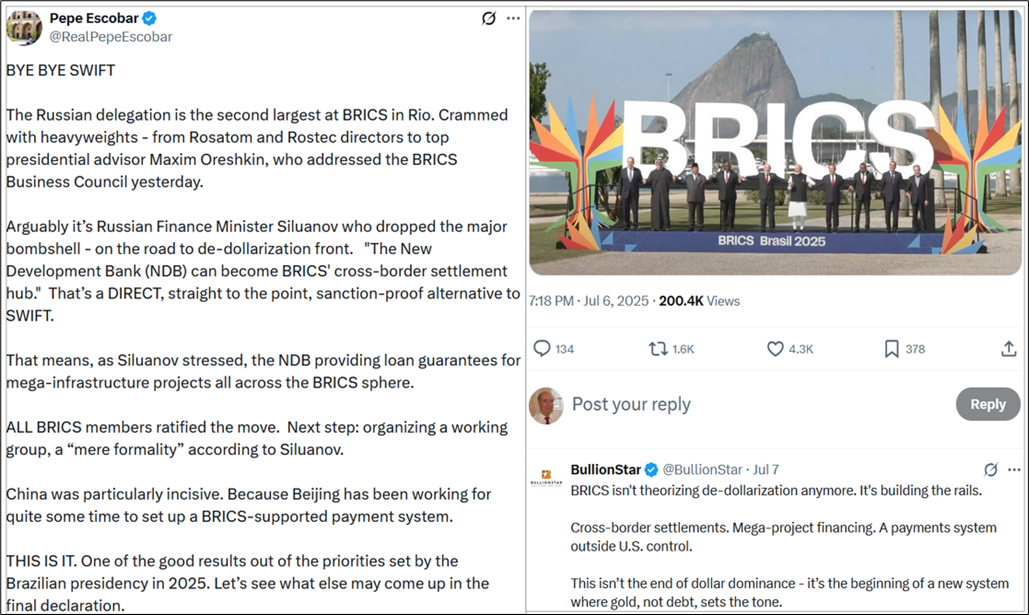
Now, BRICS has ten full members and ten official partner countries. Countries, such as Pakistan, Sri Lanka and Bahrain have expressed interest in joining. Donald Trump’s use of tariffs, as well as the threat of international sanctions, may very well inspire other countries to join BRICS as a reaction to US financial bullying. Maybe it is true… Size does matter.
Trump’s crusade against BRICS
July 8, the United States will introduce import duties of 10% in respect of BRICS members, President Donald Trump said. “Well, if they are a member of BRICS, they’re going to have to pay 10% tariff just for that,” Trump said. “BRICS was set up to hurt us,” the US leader said. “BRICS is not, in my opinion, a serious threat,” he continued. “But what they’re trying to do is destroy the dollar, so that another country can take over and be the standard. And we’re not going to lose the standard at any time,” Trump stressed.
Trump’s threat to charge BRICS countries an additional 10% in tariffs will increase BRICS countries’ commerce between themselves, and will decrease their commerce with the US.
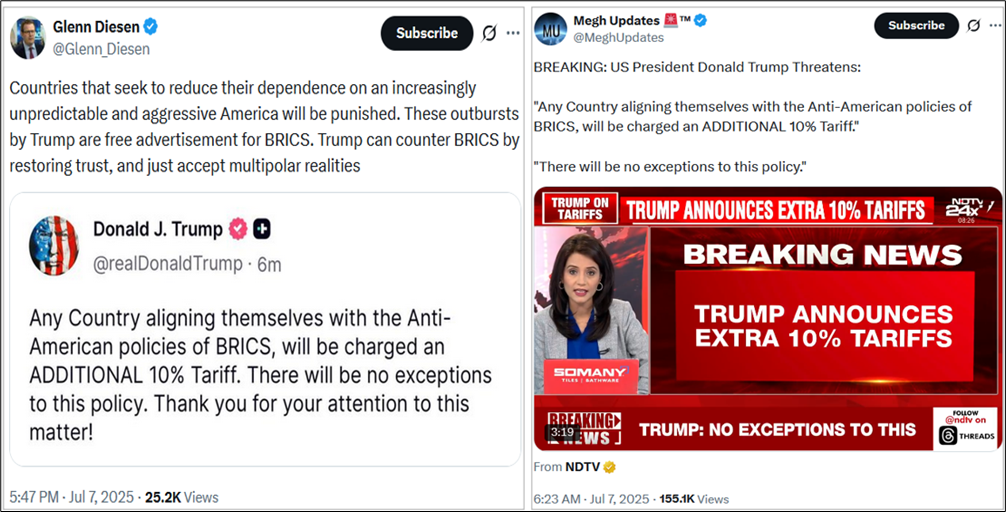
Larry C. Johnson is a former CIA officer and intelligence analyst and former planner and advisor at the US State Department’s Office of Counter Terrorism. He explained the situation in his interview with Alex Krainer, where they discuss the West’s current offensive to derail BRICS. While the Western media, especially the establishment media in the United States, continue to ignore BRICS and pretend that nothing important is happening, Larry believes that the financial leaders privately recognize that BRICS presents a potentially formidable threat to a Western-dominated financial system. Furthermore, he believes that the Western intelligence agencies are working feverishly to sow unrest in Armenia, Azerbaijan, Georgia, Iran, India and Pakistan in order to throw a monkey wrench into BRICS, as it works to develop an alternative to being held hostage to the US dollar.
Larry Johnson & Alex Krainer:
Discover the covert geopolitical moves behind the West’s efforts to derail BRICS and multipolar integration. From Trump’s shifting stance to rising tensions with Azerbaijan and Serbia, this video reveals the forces shaping the global order and the high-stakes struggle for power. Alex Krainer, an economic analyst, brings invaluable insights into the forces at play and what’s really behind these maneuvers.

US War Against BRICS Kicks Into Overdrive I Alex Krainer Interview
Counter Currents, July 6, 2025
Why Trump’s Trade War Could Strengthen BRICS | Vantage with Palki Sharma
Firstpost, July 7, 2025
Donald Trump has threatened BRICS nations with additional tariffs, warning that any country aligning with the bloc’s “anti-American policies” will face a 10% penalty. His remarks came as the expanded BRICS group — now including Indonesia, Egypt, Ethiopia, the UAE and Iran — convened in Brazil. BRICS leaders rejected the US stance, calling tariff wars coercive and damaging to global trade. Despite Trump’s warnings, trade within BRICS has risen by 40% since 2021, driven by growing bilateral deals and de-dollarisation efforts. Analysts say Trump’s threats can backfire, strengthening the bloc’s resolve and accelerating alternatives to American trade and currency.
The BRICS countries are gradually stepping in to fill a growing soft-power vacuum that has emerged due to US President Donald Trump’s policy of pulling out of international organizations and alienating other nations with tariffs.
The BRICS group is striving to become a credible alternative to the current international order amid Washington’s actions. This was underscored by the two-day BRICS Summit that concluded in Rio de Janeiro on Monday. The participants took a firm stance on strengthening multilateralism, tackling climate change, and setting international standards for artificial intelligence governance. The summit demonstrated that BRICS is becoming an authoritative voice for the Global South.
Washington appears to be stepping back in several areas. During Trump’s second presidential term, the US has withdrawn from the World Health Organization (WHO) and the Paris Agreement on climate change, undermined the World Trade Organization, engaged in unilateral military action against Iran and scaled back international aid. While the United States is becoming “increasingly unpredictable” due to its trade policy based on the “America First” principle, BRICS upholds the international trade order, its rules and norms.

Trump’s 10% Tariff Just Shook BRICS as U.S. Debt Hits a Breaking Point
ITM TRADING, INC., July 8, 2025
“Tariffs, gold, and the great unraveling.” Adrian Day, CEO of Adrian Day Asset Management, joins Daniela Cambone at the Rule Symposium in Boca Raton to unpack the global crosswinds shaking the foundation of U.S. dominance. From Trump’s new 10% tariff threats against BRICS-aligned nations to Powell’s reluctance to cut rates, Day sees deep contradictions in U.S. policy — and a brewing inflection point for the dollar. He warns of a silent shift away from the dollar as a reserve currency, citing its sharp decline in central bank holdings, and points to record debt servicing costs as the real driver behind coming rate cuts. Amid shaky CPI data, political brinkmanship, and a confused Fed, Day argues gold remains the ultimate hedge. “The messaging is broken. The math is unsustainable. But the case for gold? Stronger than ever.”
“Trump Said It… And Now They’re RETALIATING… | Pepe Escobar”
Unfiltered Minds, July 12, 2025
Investigative journalist Pepe Escobar reports from the July 2025 BRICS summit in Rio, revealing how the 10-nation bloc has shifted from talk to action. On Day 1 the members issued a rare, unanimous declaration condemning Israel’s assault on Gaza and warning against strikes on Iran—language tougher than recent UN statements. Behind the scenes, finance ministers green-lit a plan to route development loans and trade through the New Development Bank and a cross-border “M-Bridge” settlement unit, moving another step closer to dollar-free commerce. Escobar details how Russia and China have spent the past year building this plumbing, why Sergei Lavrov is steering the effort, and how BRICS leaders now see themselves as a “post-West” alternative to the old Bretton Woods order. The discussion turns fiery when Trump slaps a 50 % tariff on Brazilian orange-juice exports—triggering threats of equal retaliation and casting the tariff as political meddling ahead of Brazil’s 2026 election. By the summit’s end, Escobar says, BRICS is “playing offense,” determined to set the rules of tomorrow’s global economy rather than reacting to yesterday’s.
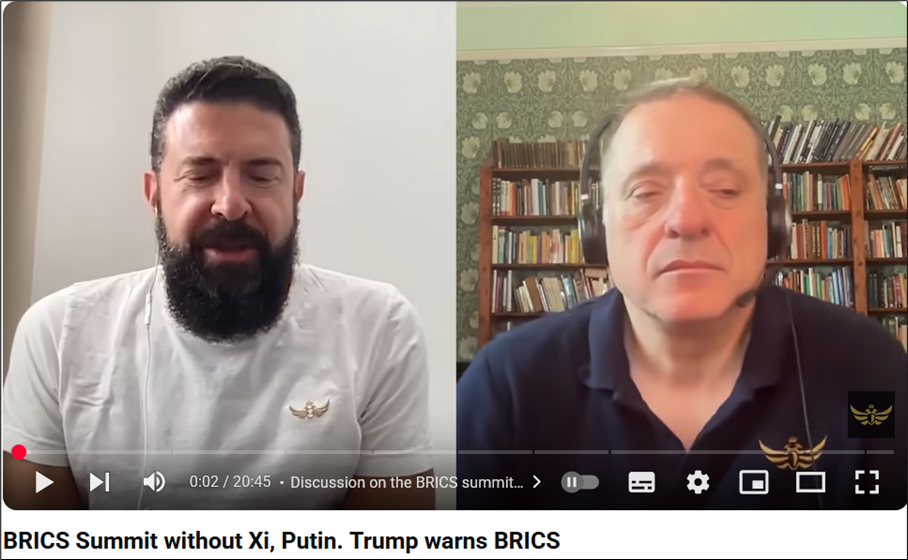
BRICS Summit without Xi, Putin. Trump warns BRICS
The Duran, July 7, 2025
Here below a drafted schema for De-dollarization and Re-monetizing Gold.
The BRICS Summit 2025 in the framework of de-dollarization and remonetizing gold
July 2025 appears to be significant for several reasons. As of July 1, 2025, gold will officially be classified as a Tier 1, high-quality liquid asset (HQLA) under the Basel III banking regulations. That means the banks can count physical gold, at 100% of its market value, toward their core capital reserves. Trump’s Tariff cease-fire with China is scheduled to expire. But for gold market observers in 2025, the central event is neither seasonal nor regulatory. It’s geopolitical: the upcoming BRICS Summit, scheduled for July 6–8, immediately following the US Independence Day holiday.
The BRICS 2025 De-dollarization Endgame, Gold as a Collateral System
Gold becomes the store of value. Yuan becomes the international medium of exchange. Blockchain becomes the unit of account ledger in the multipolar rollout. Contents:
- The BRICS Plan: Gold Collateral, and Yuan Internationalization
- The Real Agenda: Gold Guarantees the System
- The Yuan-Gold Dual System: Razor and Blade
- China’s BRICS 2025 Rollout Plan
- The Role of Blockchain and mBridge
- SGEI and the Quiet Test of the System
- The Coming Announcement
- Strategic Implications
- Conclusion: Gold Returns, with a twist
As the world’s financial architecture fractures along geopolitical lines, this year’s BRICS Summit appears poised to deliver a significant, if underappreciated, evolution in global trade mechanics. While headlines may focus on digital currencies, de-dollarization rhetoric, or commodity pricing shifts, the real development lies in something more physical, and far more consequential: the internationalization of gold as collateral. And central to that plan is how gold will interface with the yuan—China’s currency—as BRICS nations construct a cooperative vault infrastructure designed to spread usage, reduce distrust, and enable sovereign flexibility in trade.
The Real Agenda: Gold Guarantees the System
In the BRICS summit 2025, this year’s core financial innovation is rooted in the creation of a multi-jurisdictional gold custody network. These vaults, currently under construction or negotiation in China, Saudi Arabia, Southeast Asia, and Africa, represent far more than logistical upgrades. They are the structural backbone of a new settlement system where gold is the primary collateral asset, replacing the US Treasury bond as the standard bearer of trust.
In the legacy SWIFT system, Treasuries have played that role. Dollar-denominated bonds provided the liquidity, yield, and presumed security needed to lubricate global trade. But now, for political and structural reasons, many nations—especially BRICS members—no longer view Treasuries as neutral or safe. The demand, therefore, is for a new currency and a new form of collateral: one that is apolitical, finite, and universally recognized.
Gold holds historical and monetary weight as a bearer asset. But its integration into modern systems has always been limited by three issues: trust, settlement speed, and physical verification. This year’s BRICS summit, backed by work already done by China through the Shanghai Gold Exchange International (SGEI), is addressing all three.
The Yuan-Gold Dual System
China has made no secret of its ambition to internationalize the yuan. But it understands that the yuan cannot achieve global acceptance simply through decree or political alignment. Currencies succeed when they offer both utility and trust. China has built utility through trade deals, swap lines, and cross-border payment systems. Now, it seeks to build trust.
The model is simple, but powerful: gold serves as the store of value, while the yuan functions as the medium of exchange. The two operate as complementary halves of a single monetary system. Critically, the system is built on optionality. Participants are not required to convert yuan into gold, but they may do so. In effect, this introduces a convertibility layer into the yuan that mimics the gold window of Bretton Woods without forcing a formal gold standard. It’s a model that offers flexibility for central banks, credibility for counterparties, and ballast for the currency itself.
China’s BRICS 2025 Rollout Plan
The challenge with any gold-based system is the physicality of the asset. Where is it stored? Who verifies it? How can you prevent theft, duplication, or manipulation? The BRICS answer: geographic diversification and collective oversight.
The plan unveiled—implicitly and soon formally—by China involves the creation or certification of multiple gold vaults across the BRICS landscape. These include:
- A Saudi-based vault built with SGEI participation, allowing for direct RMB-gold conversion from oil proceeds.
- Vaults in Singapore and Malaysia, where regional trade partners can store and pledge gold for RMB-denominated credit lines.
- African and Middle Eastern vaults integrated into the system via the Belt and Road logistics infrastructure, enabling pledge-based infrastructure financing.
- Continued expansion of the Shanghai vault network, linked to international clients via SGEI, where gold is allocated separately from domestic reserves.
Rather than centralizing gold in a single jurisdiction (as the U.S. does at Fort Knox or the NY Fed), this model emphasizes mutual hostage-taking. Each BRICS member places a portion of their gold in the vaults of other members. Your gold is in my country; mine is in yours. This prevents any one actor from dominating the system and provides a natural check on bad behavior.
As one analyst put it, “They’re not reinventing anything. They’re just resurrecting the only thing that ever worked.”
The Role of Blockchain and mBridge
Speed and auditability have always been weaknesses in physical gold systems. To solve this, BRICS leaders are layering on modern architecture: blockchain and a central bank digital currency platform called mBridge.
Blockchain enables real-time auditing and verification of gold ownership across distributed vaults. mBridge enables interoperability between central banks, allowing them to settle claims backed by gold without needing to move the metal.
This solves both the trust problem and the speed problem. Gold remains stationary, but ownership can change instantly. It is “slow money” moving at “fast money” velocity. This changes everything.
The Coming Announcement
If this year’s BRICS Summit does unveil this vault architecture formally, expect it to be framed as a cooperative clearing mechanism. Some expect the name “BRICS Clear” to be used. It will emphasize the voluntary nature of participation, the neutral qualities of gold, and the role of blockchain for transparency.
But beneath the surface, it represents the re-monetization of gold—not as currency, but as collateral guaranteeing currency validity. Gold isn’t replacing fiat currencies. It is replacing what guarantees them, specifically Treasuries.
Strategic Implications:
- For China, it reduces its reliance on U.S. Treasuries and boosts yuan legitimacy.
- For Saudi Arabia, it offers a safe(r) store of value while maintaining oil exports.
- For Africa and Southeast Asia, it opens the door to gold-backed infrastructure finance without IMF oversight.
- For Russia, it enables trade outside of SWIFT and EU banking systems.
- For Western investors, it changes the role of gold from a defensive asset to a systemic one.
And for the global monetary order, it represents the return of an old foundation—updated for a digital age.
Conclusion: Gold Returns, with a Twist
This year’s BRICS Summit will be about architecture—about the building of a distributed, physical, and digital network in which gold is the collateral, yuan is the settlement medium, and trust is engineered through transparency and geographic diversification.
If successful, BRICS will have reintroduced gold into the international system—for pragmatic purposes. And in doing so, they will have built a monetary bridge away from the dollar, and a clearinghouse for the multipolar world.


